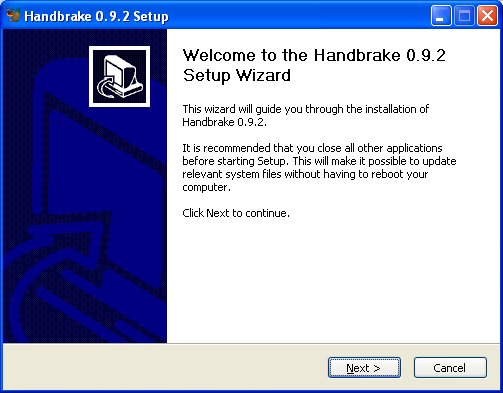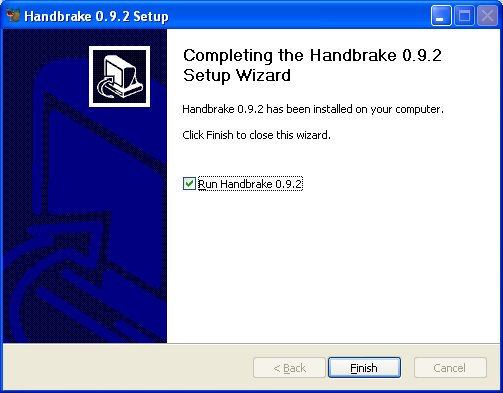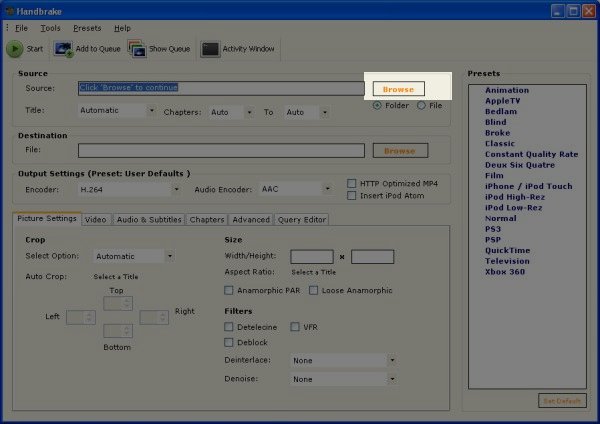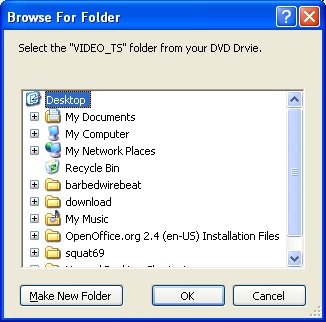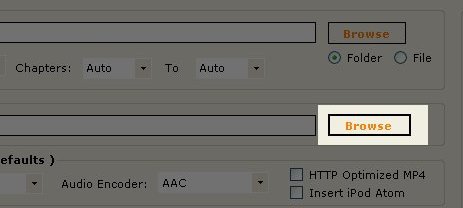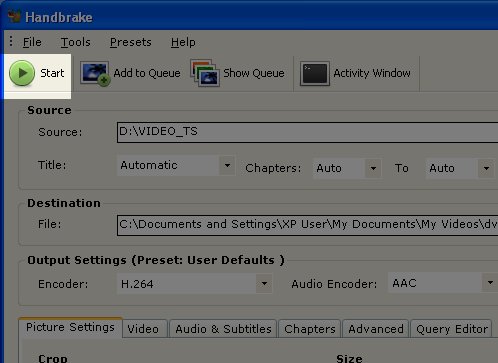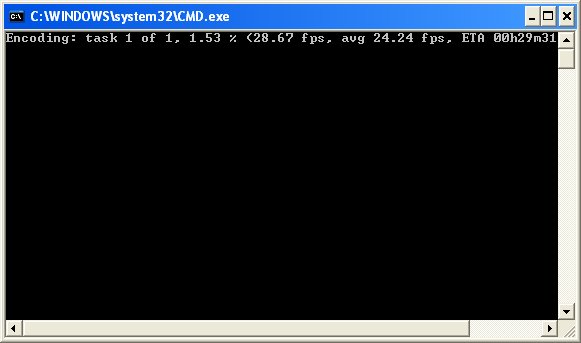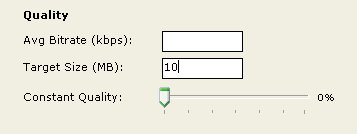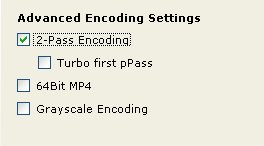Installing on Ubuntu
Software name : Handbrake
Homepage : http://handbrake.fr
Software version used for this installation : 0.9.3
Operating System use for this installation : Ubuntu 9.04
Recommended Hardware : 400 Mhz processor (CPU) minimum, internet connection
There is a trick to installing Handbrake on Ubuntu...Either you do it the hard way - using a terminal...or you do it the easy way - mostly within Firefox...we will do it the easy way.
Before you start you must check that you have sudo access. This means that you have to have the privileges to implement superuser or root actions. If you are working on your own computer then you will have this access. If you are working on a shared machine that someone else set up then you might not have this level of access and so you should ask the person that owns or administrates the computer to give you sudo access.
Download the File
This method uses the Firefox browser, so make sure you follow these setps using Firefox. Firefox is the default browser for Ubuntu. First we must download the binary - a 'binary' is another word for 'executable'. Both these terms are really another word for 'program' or 'software'.
For command line programs we usually refer to 'binaries' because it sounds geekier.
To download this binary visit the Handbrake download home page : http://handbrake.fr/?article=download

Choose the "Command Line Interface (i386 Binary)" download link.

This will start the download process :

Just press 'OK' and the file file will download. If you want to change the download location for the files you need to do this through the preference settings in your browser.While it is downloading you will be presented with a nice progress bar :

If you can't find the window showing this information then look in the panel that shows all the different softwares that are currently open. By default this panel in Ubuntu is at the bottom of the screen. You are looking for the" Firefox Download Window" :

When you find this, click on it and the download window will appear.
Now the file has downloaded the progress bar will disappear :

Extract the File
You have downloaded the installer but it is in the form of an archive. An archive is a container of files that have been compressed to make the total file size smaller. Often files are compressed like this to ensure speedy downloading. We need to decompress the archive. Normally in Linux this is done using the 'terminal' - this is fast and efficient if you know how. If you don't know how then it can be confusing. So we will look at a far simpler way to do this which is just as quick.
To decompress the Handbrake installer you must only double-click on the file name displayed in the download window. The contents of the archive are then displayed :

The above window is actually an archive manager program that Ubuntu uses called File Roller. Firefox can automatically open File Roller like this when the downloaded file is a type of archive.
The list of folders and directories you will see displayed (in this case, just one file) is a list of items inside the archive. We still need to decompress the files we want. In this case we just want the one file displayed so we right-click on this flie :

Now choose the "Extract..." option and a file browser will appear :
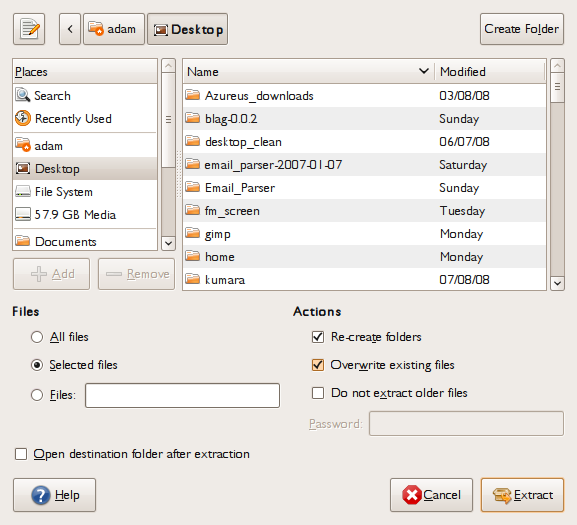
Choose where you wish to extract the file - do tis by clicking on the folders in the file browser to find the location for the file and then press "Extract".
I have extracted my file to the Desktop. Now we need to copy this file to the place where all the binaries are stored on your operating system. To do this you must first open a terminal.
Starting a Terminal
Now...starting a shell...what is a 'terminal' you might ask. Well, inorder to issue commands we have to use an application called a terminal. It can also be referred to as a 'shell' or simply a 'command line'. Ubuntu refers to it as a 'terminal' so we will stick to that terminology. The terminal is a very powerful application. From it you are pretty much master of the Linux Universe. Want to make a new folder? Its easy from tusing commands in the terminal...want to whipe out your entire Operating System?...no problems, one short command will do it (but for your own safety I aren't going to tell you which).
You can just about do anything with a terminal and a few commands. Before you do that however you need to open the terminal. Assuming you have the standard Ubuntu installed you will see at the top of the screen there is a navigation bar with a menu including three items: 'Applications'. Places', and 'System' :

Now click on 'Applications', then slide across to 'Accessories', and then 'Terminal':

Now we are cooking. The terminal should pop up:
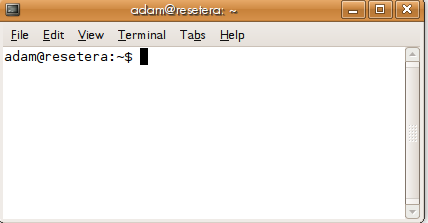
Yours may look a little different. Don't worry, as long as it almost looks the same you are ok. Now, you are located in your 'home' directory. When you start a terminal it is always in the home directory. By this I mean that any command you will now issue will be enacted 'from' the home directory. Don't dwell on this too much, if you don't understand it then the understanding will come after using the terminal a little.
Copy Binary to Bin
All binary files are stored in one of two places : the 'bin directory and the 'sbin' directory. The later is for storing binaries that are used by the root user (also know as the superuser). We wish to use the 'bin' directory.
With the terminal you have to change directories to the location of the Handbrake binary. For this we use the cd command. I already know that Handbrake has been extracted to the Desktop, and my terminal opened immediately in my home directory. So I only need to type the following :
cd Desktop
This will take me to the location of the Handbrake binary. I could also have used a fullpath to my Desktop which would mean typing the following :
cd /home/adam/Desktop
You must work through the possiblities of finding the binary on your computer. You may wish to read more about the Linux file system and the cd command to be able to do this.
I am now 'in the Desktop' and I can copy Hanbrake to the 'bin' directory with a simple command. I will use the cp command. This is used to copy any file or files from one place to another. The binary is called 'HandBrakeCLI' and I must copy it to '/usr/bin' so the command I use is this:
cp HandBrakeCLI /usr/bin
Except...a normal user can not copy files to the 'bin' directory. So you must use the sudo command. A 'sudo' commad can preceed any other command and it merely means 'execute this action as the superuser'. Superuers can copy files to 'bin', so we type this in the terminal :
sudo cp HandBrakeCLI /usr/bin
You will then be asked for a password. Type in your own user account password (the password you used to log in) and press return. If you have the correct rights to execute commands as sudo the file will be copied to bin. If you do not have the right access priviledges you need to ask your local Ubuntu guru how to get them.
To test if Handbrake now works type this in the terminal :
HandBrakeCLI --help
You should see a whole lot of information appear telling you how to use Handbrake on the command line.
Picture Settings
When using
Handbrake you can set a
Source Disk and an
output filename and click "Start" and Handbrake will automatically create a suitable file of abut 10 MB per minute. This is te default. However you may want to change the
Picture Settings to specify more acurately what kind of file you would like to create.

The picture settings section is at the bottom of the default screen of Handbrake. You should be able to see it by default when you open up the application. However if you have altered other settings then you will need to click on the Picture Settings tab as show below.

Image Size and Shape
If you don't enter a size for Picture Settings then Handbrake will try to work out the most appropriate size. I would reccomend not changing the size here as doing so creates unpredictable results.
If you do enter a size then only enter the
width that you want the video to be, and let Handbrake work out the appropriate height - this will save you having to calculate this manually.
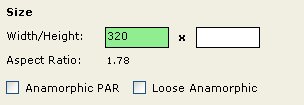
Handbrake recognises the shape of the
DVD and it illustrates this in the
Size section below the width and height. The shape is know as the
Apsect Ratio. In the above example it shows ('1.78' which is also known as 16:9 and is a kind of 'wide screen'. 1:33 also known as 4:3 is normal old TV shape.
In the Size section there are some more detailed settings for
Anamophic or
Widescreen. You may want to specify the exact size of the target file that you create and define the way that your video file is encoded. If do this you may get a better quality playback image. If this is something that you want to find out more about have a look at the resources here.
http://trac.handbrake.fr/wiki/AnamorphicGuide
Adding a Deinterlace Filter
Adding a
deinterlace filter is often one of the most overlooked steps when encoding video for the internet. Getting it wrong leads to badly encoded video files. If you have created the DVD yourself then it is likely that your video will be interlaced. If you are not sure what that means then you should look at the next image.

You can see jagged lines on the screen where ever there is motion. These lines are caused by interlacing. If we don't add a
filter then the file we create will be much more blurry than it needs to be.
In the
Picture Settings tab of Handbrake add a deinterlace filter by selecting "Fast" from the drop down menu in the
Deinterlace section :

You can then adjust the other Handbrake settings to your needs before clicking on "Start" to encode your video.
License
All chapters copyright of the authors (see below). Unless otherwise stated all chapters in this manual licensed with GNU General Public License version 2
This documentation is free documentation; you can redistribute it and/or modify it under the terms of the GNU General Public License as published by the Free Software Foundation; either version 2 of the License, or (at your option) any later version.
This documentation is distributed in the hope that it will be useful, but WITHOUT ANY WARRANTY; without even the implied warranty of MERCHANTABILITY or FITNESS FOR A PARTICULAR PURPOSE. See the GNU General Public License for more details.
You should have received a copy of the GNU General Public License along with this documentation; if not, write to the Free Software Foundation, Inc., 51 Franklin Street, Fifth Floor, Boston, MA 02110-1301, USA.
Authors
BASIC USE
© mick fuzz 2008
Modifications:
adam hyde 2008
CREDITS
© adam hyde 2006, 2007
Glossary
© adam hyde 2006, 2007
Help
© adam hyde 2006, 2007
UBUNTU
© adam hyde 2007
INTRODUCTION
© adam hyde 2006, 2007, 2008
Modifications:
Matthias Sweertvaegher 2010
mick fuzz 2008
PICTURE SETTINGS
© mick fuzz 2008
Modifications:
adam hyde 2008
PRESETS
© mick fuzz 2008
Modifications:
adam hyde 2008
VIDEO SETTINGS
© mick fuzz 2008
Modifications:
adam hyde 2008
WINDOWS
© mick fuzz 2008
Modifications:
adam hyde 2008

Free manuals for free software
General Public License
Version 2, June 1991
Copyright (C) 1989, 1991 Free Software Foundation, Inc.
51 Franklin Street, Fifth Floor, Boston, MA 02110-1301, USA
Everyone is permitted to copy and distribute verbatim copies
of this license document, but changing it is not allowed.
Preamble
The licenses for most software are designed to take away your freedom to share and change it. By contrast, the GNU General Public License is intended to guarantee your freedom to share and change free software--to make sure the software is free for all its users. This General Public License applies to most of the Free Software Foundation's software and to any other program whose authors commit to using it. (Some other Free Software Foundation software is covered by the GNU Lesser General Public License instead.) You can apply it to your programs, too.
When we speak of free software, we are referring to freedom, not price. Our General Public Licenses are designed to make sure that you have the freedom to distribute copies of free software (and charge for this service if you wish), that you receive source code or can get it if you want it, that you can change the software or use pieces of it in new free programs; and that you know you can do these things.
To protect your rights, we need to make restrictions that forbid anyone to deny you these rights or to ask you to surrender the rights. These restrictions translate to certain responsibilities for you if you distribute copies of the software, or if you modify it.
For example, if you distribute copies of such a program, whether gratis or for a fee, you must give the recipients all the rights that you have. You must make sure that they, too, receive or can get the source code. And you must show them these terms so they know their rights.
We protect your rights with two steps: (1) copyright the software, and (2) offer you this license which gives you legal permission to copy, distribute and/or modify the software.
Also, for each author's protection and ours, we want to make certain that everyone understands that there is no warranty for this free software. If the software is modified by someone else and passed on, we want its recipients to know that what they have is not the original, so that any problems introduced by others will not reflect on the original authors' reputations.
Finally, any free program is threatened constantly by software patents. We wish to avoid the danger that redistributors of a free program will individually obtain patent licenses, in effect making the program proprietary. To prevent this, we have made it clear that any patent must be licensed for everyone's free use or not licensed at all.
The precise terms and conditions for copying, distribution and modification follow.
TERMS AND CONDITIONS FOR COPYING, DISTRIBUTION AND MODIFICATION
0. This License applies to any program or other work which contains a notice placed by the copyright holder saying it may be distributed under the terms of this General Public License. The "Program", below, refers to any such program or work, and a "work based on the Program" means either the Program or any derivative work under copyright law: that is to say, a work containing the Program or a portion of it, either verbatim or with modifications and/or translated into another language. (Hereinafter, translation is included without limitation in the term "modification".) Each licensee is addressed as "you".
Activities other than copying, distribution and modification are not covered by this License; they are outside its scope. The act of running the Program is not restricted, and the output from the Program is covered only if its contents constitute a work based on the Program (independent of having been made by running the Program). Whether that is true depends on what the Program does.
1. You may copy and distribute verbatim copies of the Program's source code as you receive it, in any medium, provided that you conspicuously and appropriately publish on each copy an appropriate copyright notice and disclaimer of warranty; keep intact all the notices that refer to this License and to the absence of any warranty; and give any other recipients of the Program a copy of this License along with the Program.
You may charge a fee for the physical act of transferring a copy, and you may at your option offer warranty protection in exchange for a fee.
2. You may modify your copy or copies of the Program or any portion of it, thus forming a work based on the Program, and copy and distribute such modifications or work under the terms of Section 1 above, provided that you also meet all of these conditions:
- a) You must cause the modified files to carry prominent notices stating that you changed the files and the date of any change.
- b) You must cause any work that you distribute or publish, that in whole or in part contains or is derived from the Program or any part thereof, to be licensed as a whole at no charge to all third parties under the terms of this License.
- c) If the modified program normally reads commands interactively when run, you must cause it, when started running for such interactive use in the most ordinary way, to print or display an announcement including an appropriate copyright notice and a notice that there is no warranty (or else, saying that you provide a warranty) and that users may redistribute the program under these conditions, and telling the user how to view a copy of this License. (Exception: if the Program itself is interactive but does not normally print such an announcement, your work based on the Program is not required to print an announcement.)
These requirements apply to the modified work as a whole. If identifiable sections of that work are not derived from the Program, and can be reasonably considered independent and separate works in themselves, then this License, and its terms, do not apply to those sections when you distribute them as separate works. But when you distribute the same sections as part of a whole which is a work based on the Program, the distribution of the whole must be on the terms of this License, whose permissions for other licensees extend to the entire whole, and thus to each and every part regardless of who wrote it.
Thus, it is not the intent of this section to claim rights or contest your rights to work written entirely by you; rather, the intent is to exercise the right to control the distribution of derivative or collective works based on the Program.
In addition, mere aggregation of another work not based on the Program with the Program (or with a work based on the Program) on a volume of a storage or distribution medium does not bring the other work under the scope of this License.
3. You may copy and distribute the Program (or a work based on it, under Section 2) in object code or executable form under the terms of Sections 1 and 2 above provided that you also do one of the following:
- a) Accompany it with the complete corresponding machine-readable source code, which must be distributed under the terms of Sections 1 and 2 above on a medium customarily used for software interchange; or,
- b) Accompany it with a written offer, valid for at least three years, to give any third party, for a charge no more than your cost of physically performing source distribution, a complete machine-readable copy of the corresponding source code, to be distributed under the terms of Sections 1 and 2 above on a medium customarily used for software interchange; or,
- c) Accompany it with the information you received as to the offer to distribute corresponding source code. (This alternative is allowed only for noncommercial distribution and only if you received the program in object code or executable form with such an offer, in accord with Subsection b above.)
The source code for a work means the preferred form of the work for making modifications to it. For an executable work, complete source code means all the source code for all modules it contains, plus any associated interface definition files, plus the scripts used to control compilation and installation of the executable. However, as a special exception, the source code distributed need not include anything that is normally distributed (in either source or binary form) with the major components (compiler, kernel, and so on) of the operating system on which the executable runs, unless that component itself accompanies the executable.
If distribution of executable or object code is made by offering access to copy from a designated place, then offering equivalent access to copy the source code from the same place counts as distribution of the source code, even though third parties are not compelled to copy the source along with the object code.
4. You may not copy, modify, sublicense, or distribute the Program except as expressly provided under this License. Any attempt otherwise to copy, modify, sublicense or distribute the Program is void, and will automatically terminate your rights under this License. However, parties who have received copies, or rights, from you under this License will not have their licenses terminated so long as such parties remain in full compliance.
5. You are not required to accept this License, since you have not signed it. However, nothing else grants you permission to modify or distribute the Program or its derivative works. These actions are prohibited by law if you do not accept this License. Therefore, by modifying or distributing the Program (or any work based on the Program), you indicate your acceptance of this License to do so, and all its terms and conditions for copying, distributing or modifying the Program or works based on it.
6. Each time you redistribute the Program (or any work based on the Program), the recipient automatically receives a license from the original licensor to copy, distribute or modify the Program subject to these terms and conditions. You may not impose any further restrictions on the recipients' exercise of the rights granted herein. You are not responsible for enforcing compliance by third parties to this License.
7. If, as a consequence of a court judgment or allegation of patent infringement or for any other reason (not limited to patent issues), conditions are imposed on you (whether by court order, agreement or otherwise) that contradict the conditions of this License, they do not excuse you from the conditions of this License. If you cannot distribute so as to satisfy simultaneously your obligations under this License and any other pertinent obligations, then as a consequence you may not distribute the Program at all. For example, if a patent license would not permit royalty-free redistribution of the Program by all those who receive copies directly or indirectly through you, then the only way you could satisfy both it and this License would be to refrain entirely from distribution of the Program.
If any portion of this section is held invalid or unenforceable under any particular circumstance, the balance of the section is intended to apply and the section as a whole is intended to apply in other circumstances.
It is not the purpose of this section to induce you to infringe any patents or other property right claims or to contest validity of any such claims; this section has the sole purpose of protecting the integrity of the free software distribution system, which is implemented by public license practices. Many people have made generous contributions to the wide range of software distributed through that system in reliance on consistent application of that system; it is up to the author/donor to decide if he or she is willing to distribute software through any other system and a licensee cannot impose that choice.
This section is intended to make thoroughly clear what is believed to be a consequence of the rest of this License.
8. If the distribution and/or use of the Program is restricted in certain countries either by patents or by copyrighted interfaces, the original copyright holder who places the Program under this License may add an explicit geographical distribution limitation excluding those countries, so that distribution is permitted only in or among countries not thus excluded. In such case, this License incorporates the limitation as if written in the body of this License.
9. The Free Software Foundation may publish revised and/or new versions of the General Public License from time to time. Such new versions will be similar in spirit to the present version, but may differ in detail to address new problems or concerns.
Each version is given a distinguishing version number. If the Program specifies a version number of this License which applies to it and "any later version", you have the option of following the terms and conditions either of that version or of any later version published by the Free Software Foundation. If the Program does not specify a version number of this License, you may choose any version ever published by the Free Software Foundation.
10. If you wish to incorporate parts of the Program into other free programs whose distribution conditions are different, write to the author to ask for permission. For software which is copyrighted by the Free Software Foundation, write to the Free Software Foundation; we sometimes make exceptions for this. Our decision will be guided by the two goals of preserving the free status of all derivatives of our free software and of promoting the sharing and reuse of software generally.
NO WARRANTY
11. BECAUSE THE PROGRAM IS LICENSED FREE OF CHARGE, THERE IS NO WARRANTY FOR THE PROGRAM, TO THE EXTENT PERMITTED BY APPLICABLE LAW. EXCEPT WHEN OTHERWISE STATED IN WRITING THE COPYRIGHT HOLDERS AND/OR OTHER PARTIES PROVIDE THE PROGRAM "AS IS" WITHOUT WARRANTY OF ANY KIND, EITHER EXPRESSED OR IMPLIED, INCLUDING, BUT NOT LIMITED TO, THE IMPLIED WARRANTIES OF MERCHANTABILITY AND FITNESS FOR A PARTICULAR PURPOSE. THE ENTIRE RISK AS TO THE QUALITY AND PERFORMANCE OF THE PROGRAM IS WITH YOU. SHOULD THE PROGRAM PROVE DEFECTIVE, YOU ASSUME THE COST OF ALL NECESSARY SERVICING, REPAIR OR CORRECTION.
12. IN NO EVENT UNLESS REQUIRED BY APPLICABLE LAW OR AGREED TO IN WRITING WILL ANY COPYRIGHT HOLDER, OR ANY OTHER PARTY WHO MAY MODIFY AND/OR REDISTRIBUTE THE PROGRAM AS PERMITTED ABOVE, BE LIABLE TO YOU FOR DAMAGES, INCLUDING ANY GENERAL, SPECIAL, INCIDENTAL OR CONSEQUENTIAL DAMAGES ARISING OUT OF THE USE OR INABILITY TO USE THE PROGRAM (INCLUDING BUT NOT LIMITED TO LOSS OF DATA OR DATA BEING RENDERED INACCURATE OR LOSSES SUSTAINED BY YOU OR THIRD PARTIES OR A FAILURE OF THE PROGRAM TO OPERATE WITH ANY OTHER PROGRAMS), EVEN IF SUCH HOLDER OR OTHER PARTY HAS BEEN ADVISED OF THE POSSIBILITY OF SUCH DAMAGES.
END OF TERMS AND CONDITIONS


